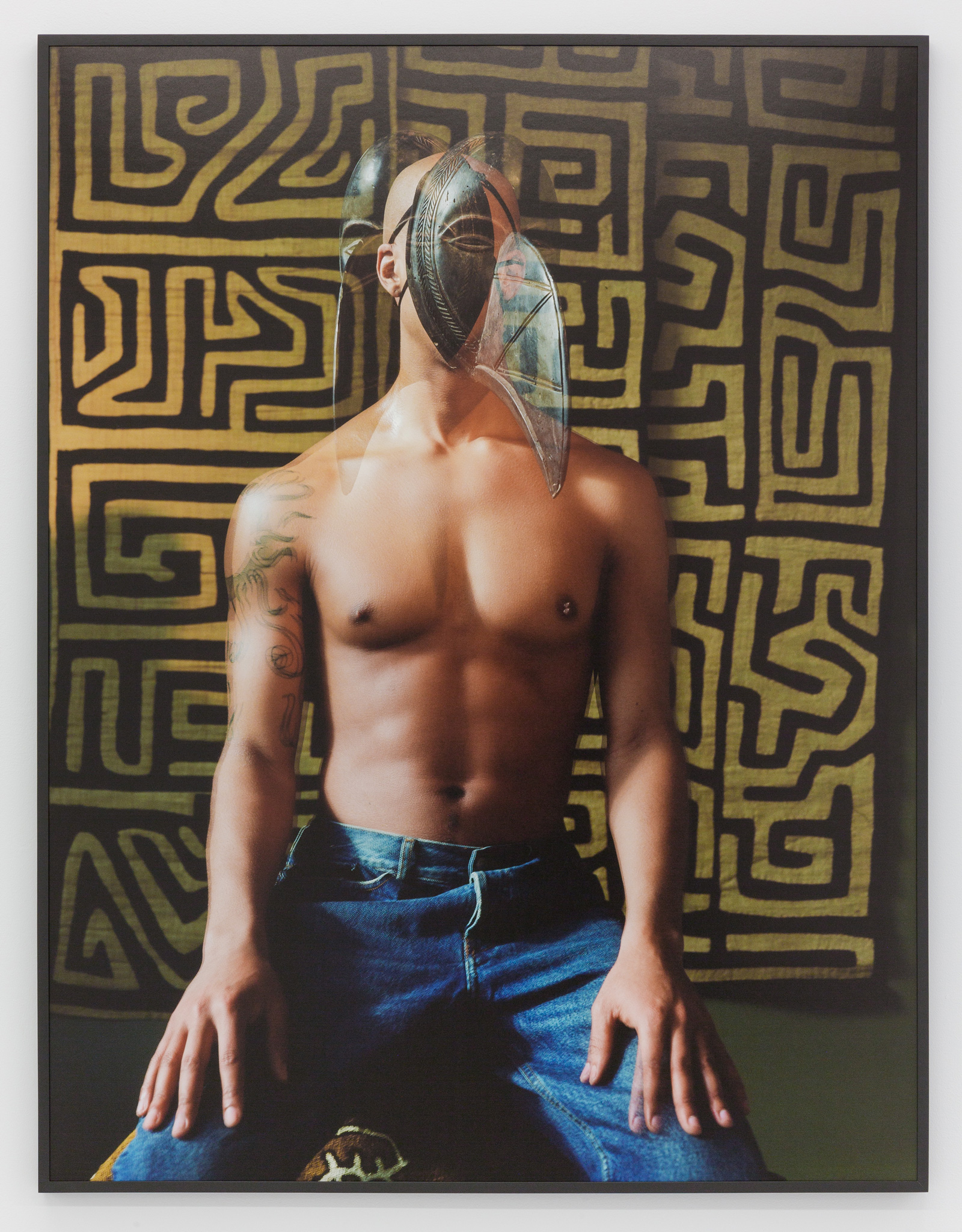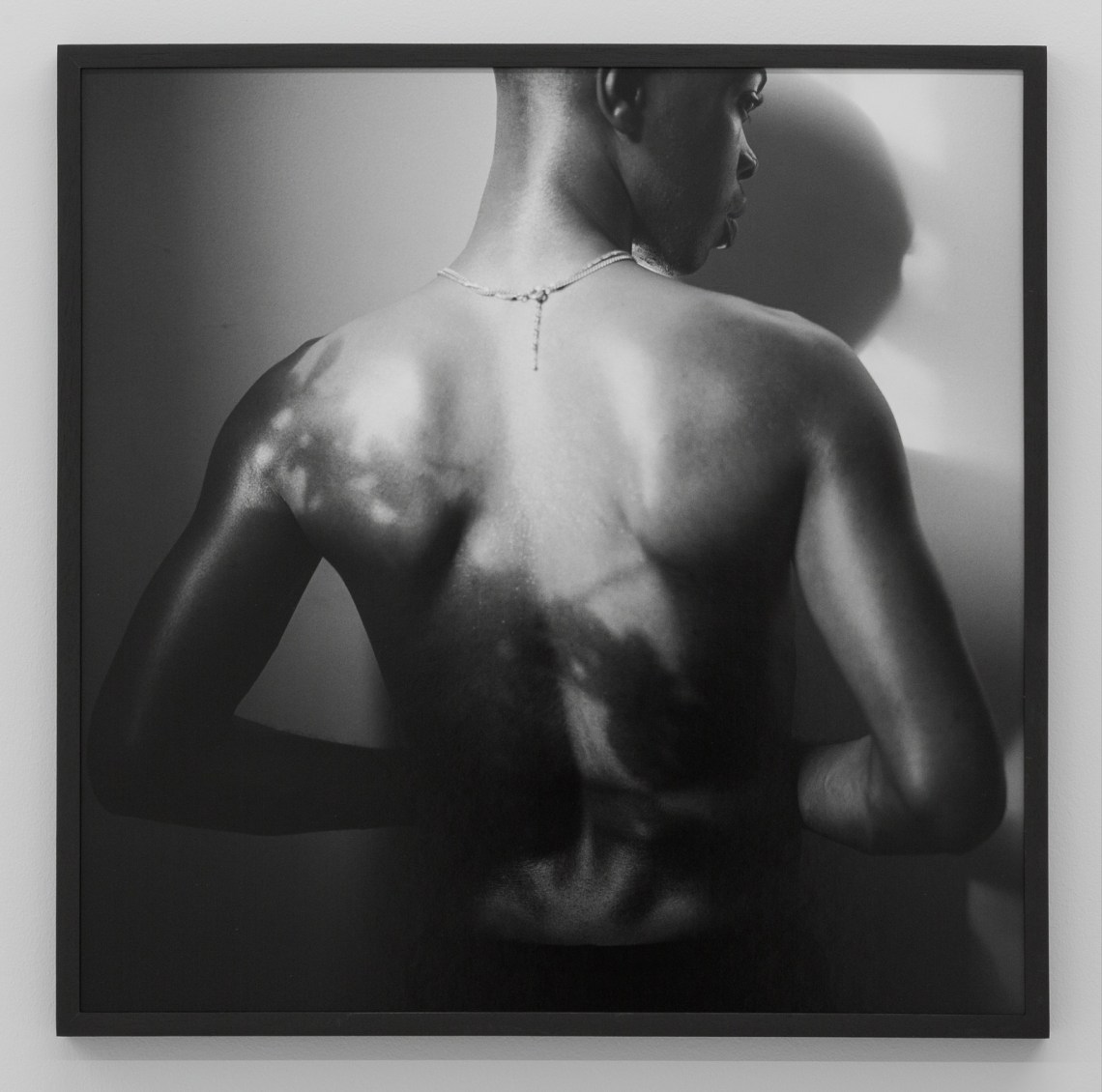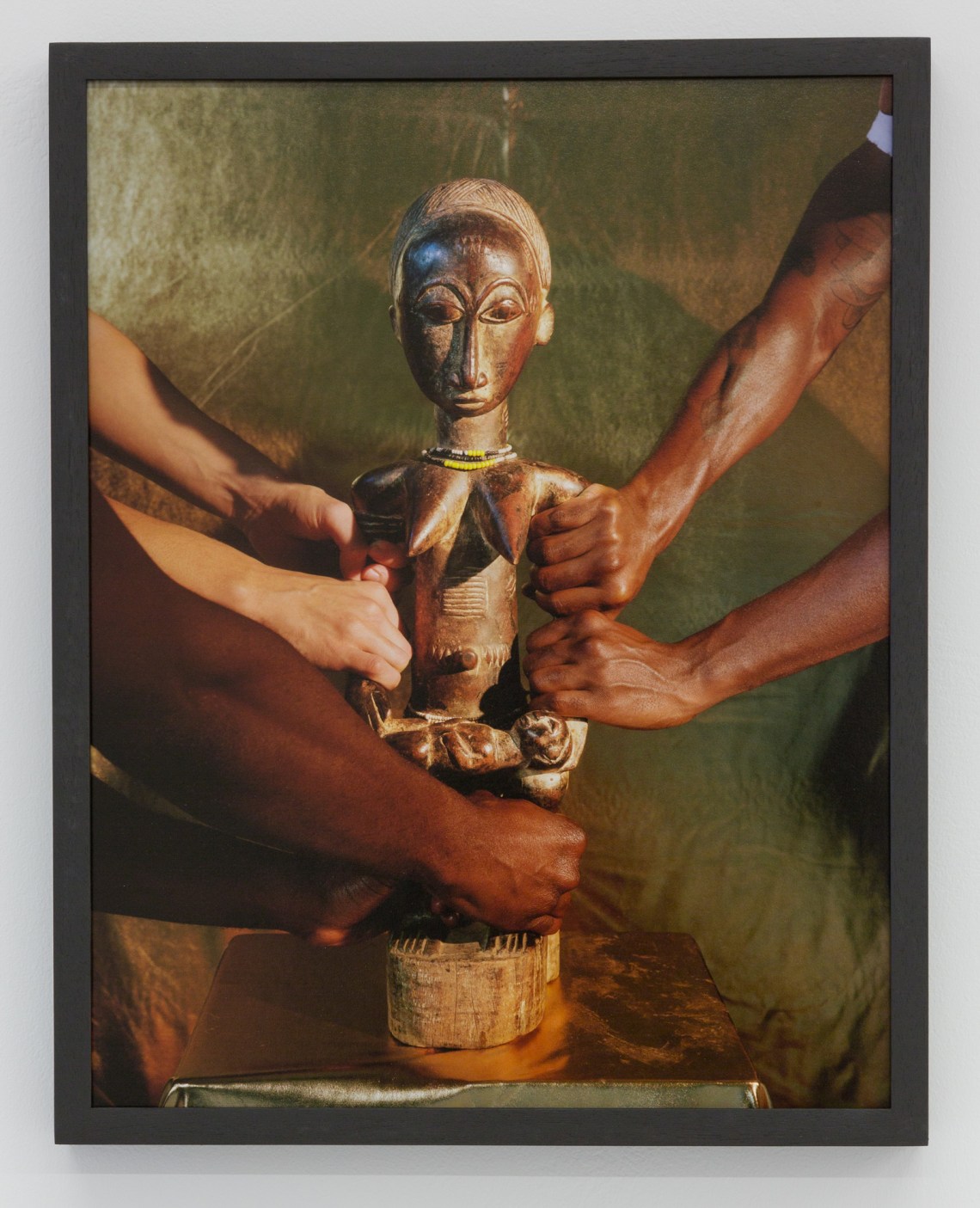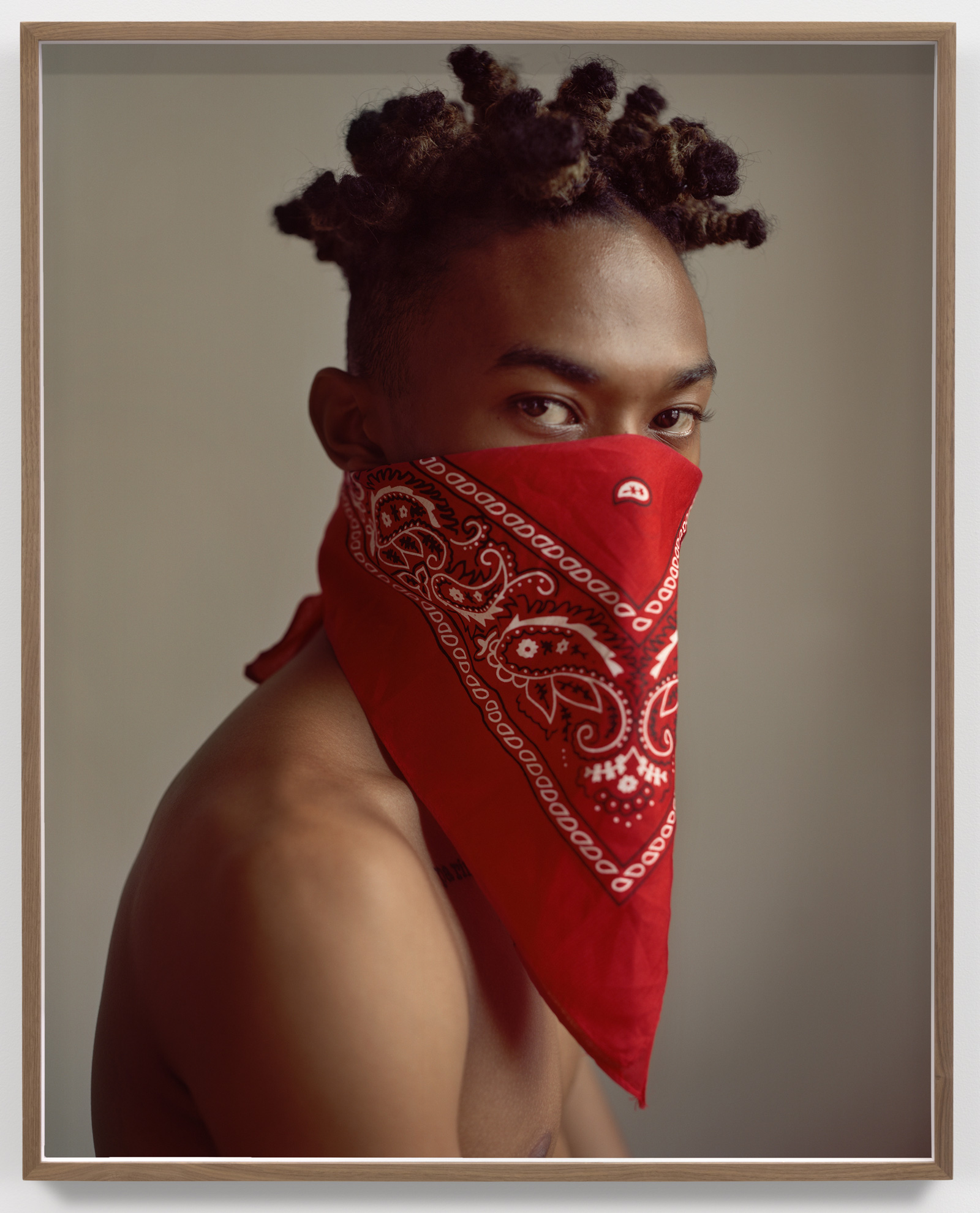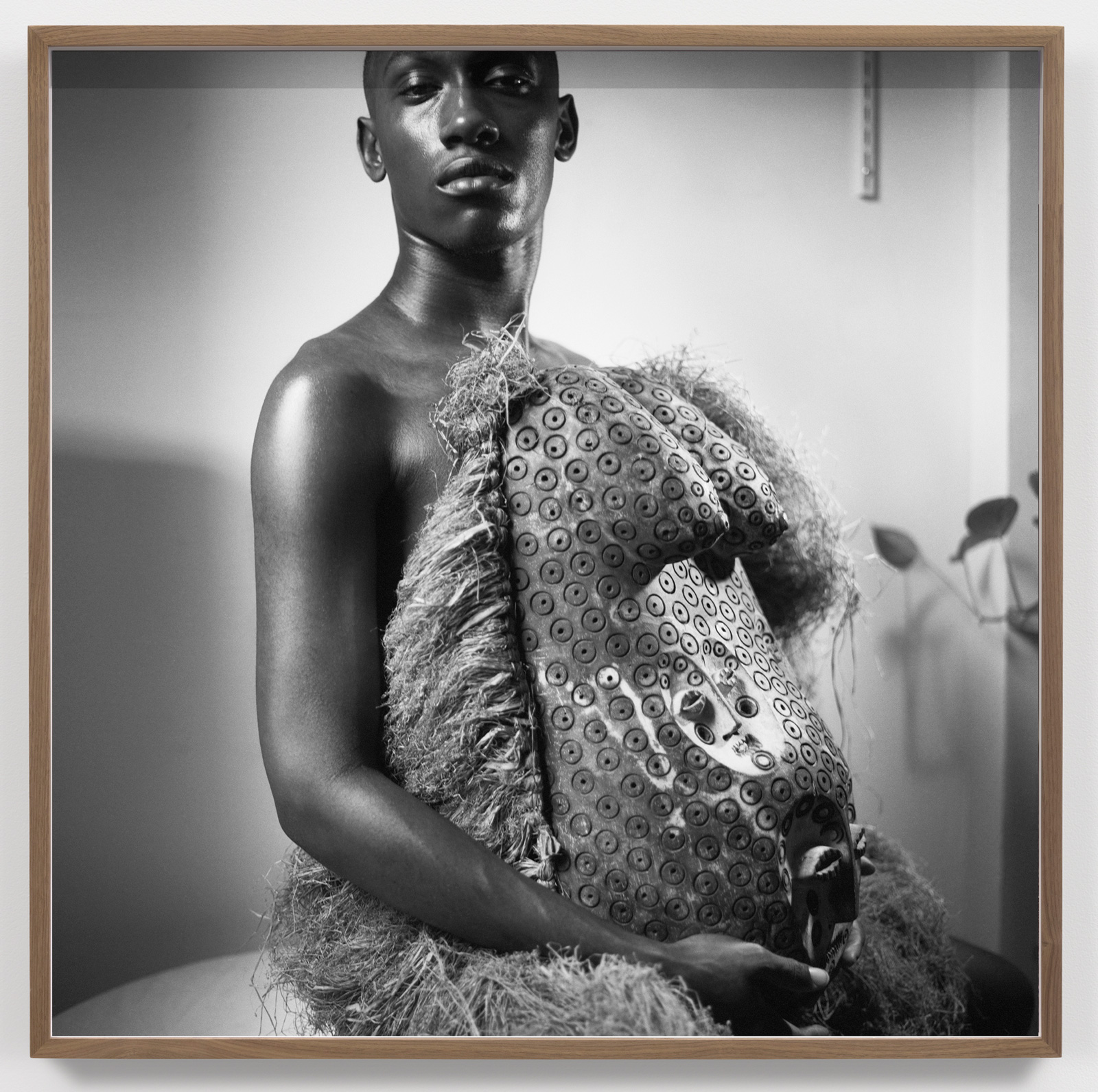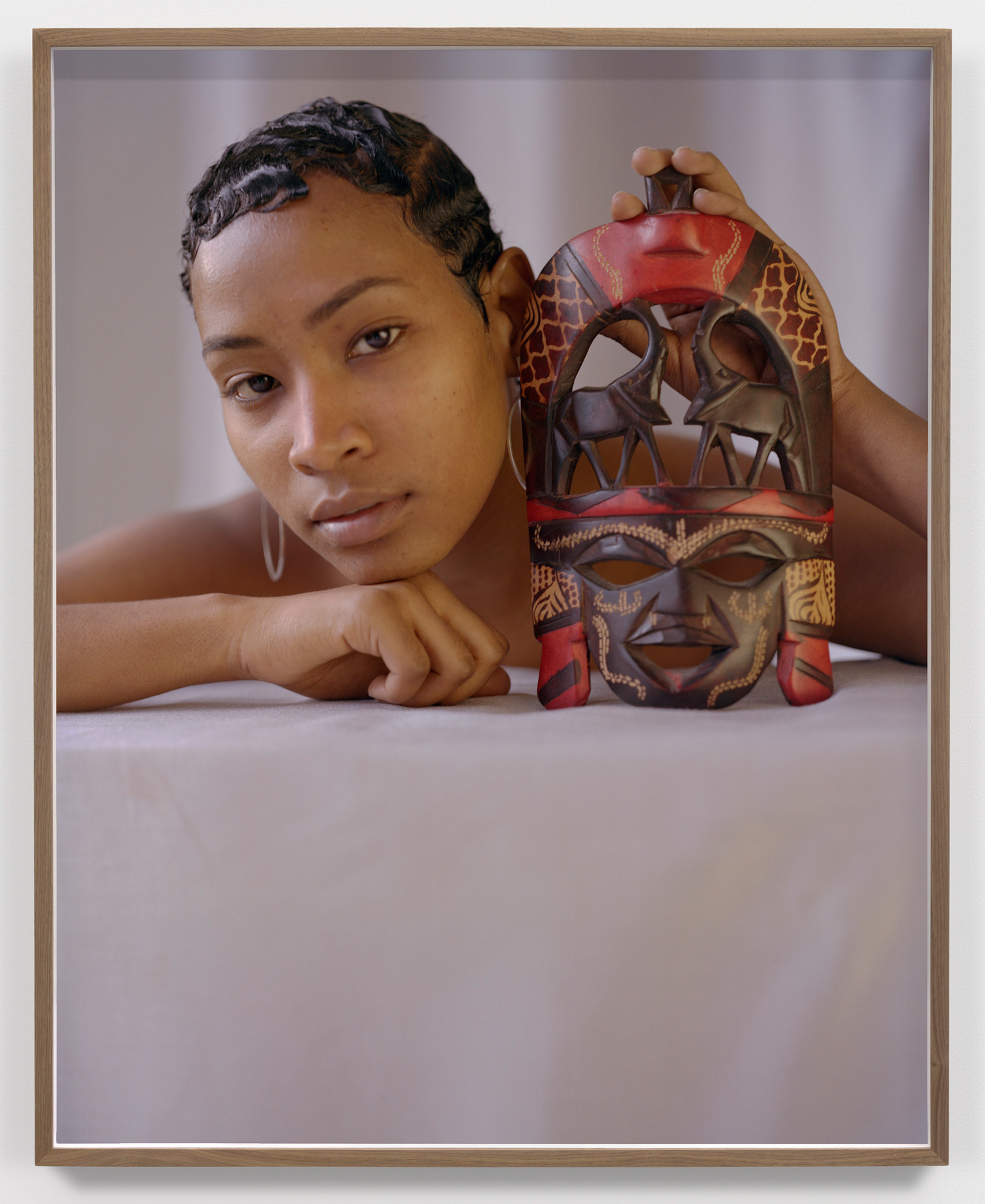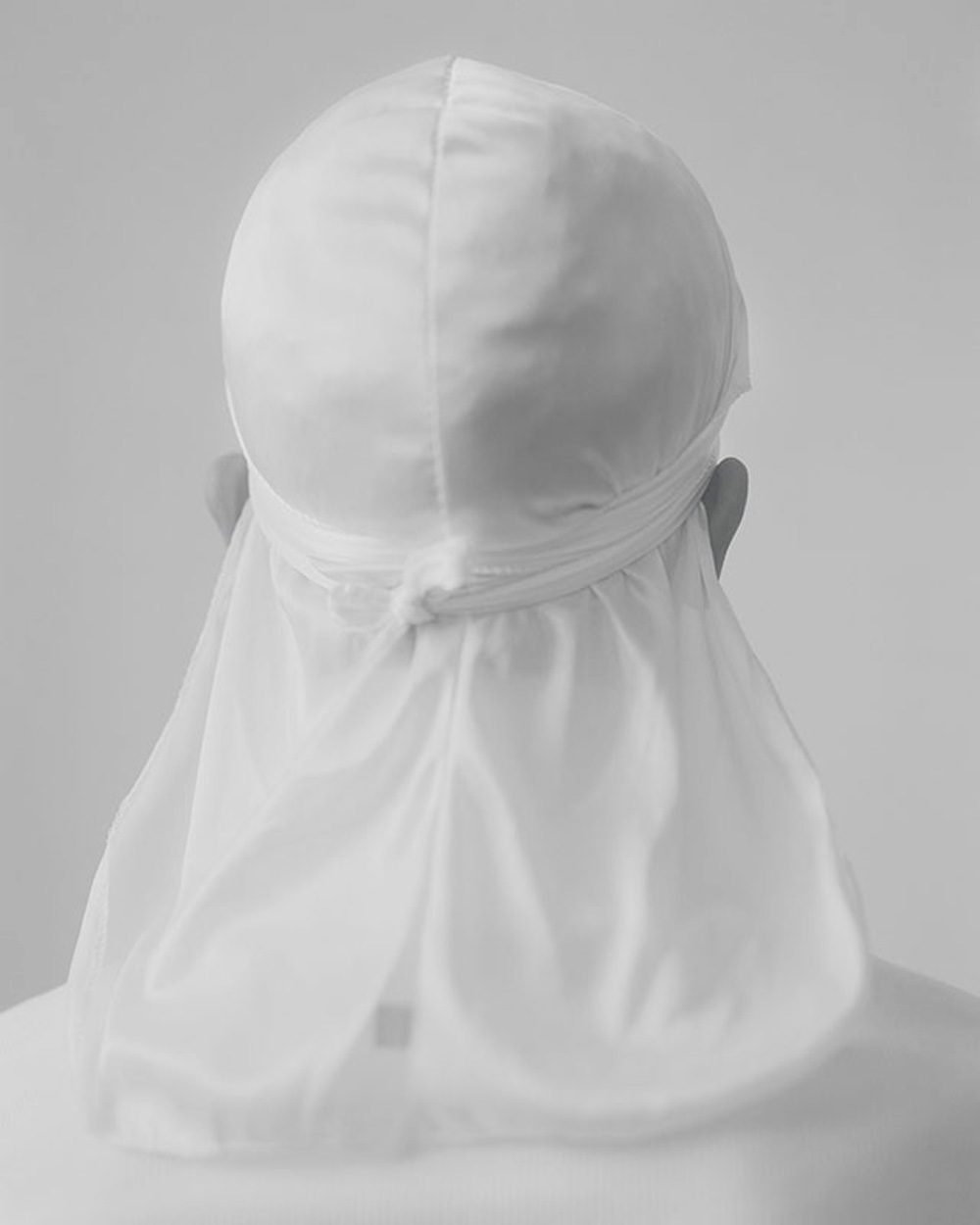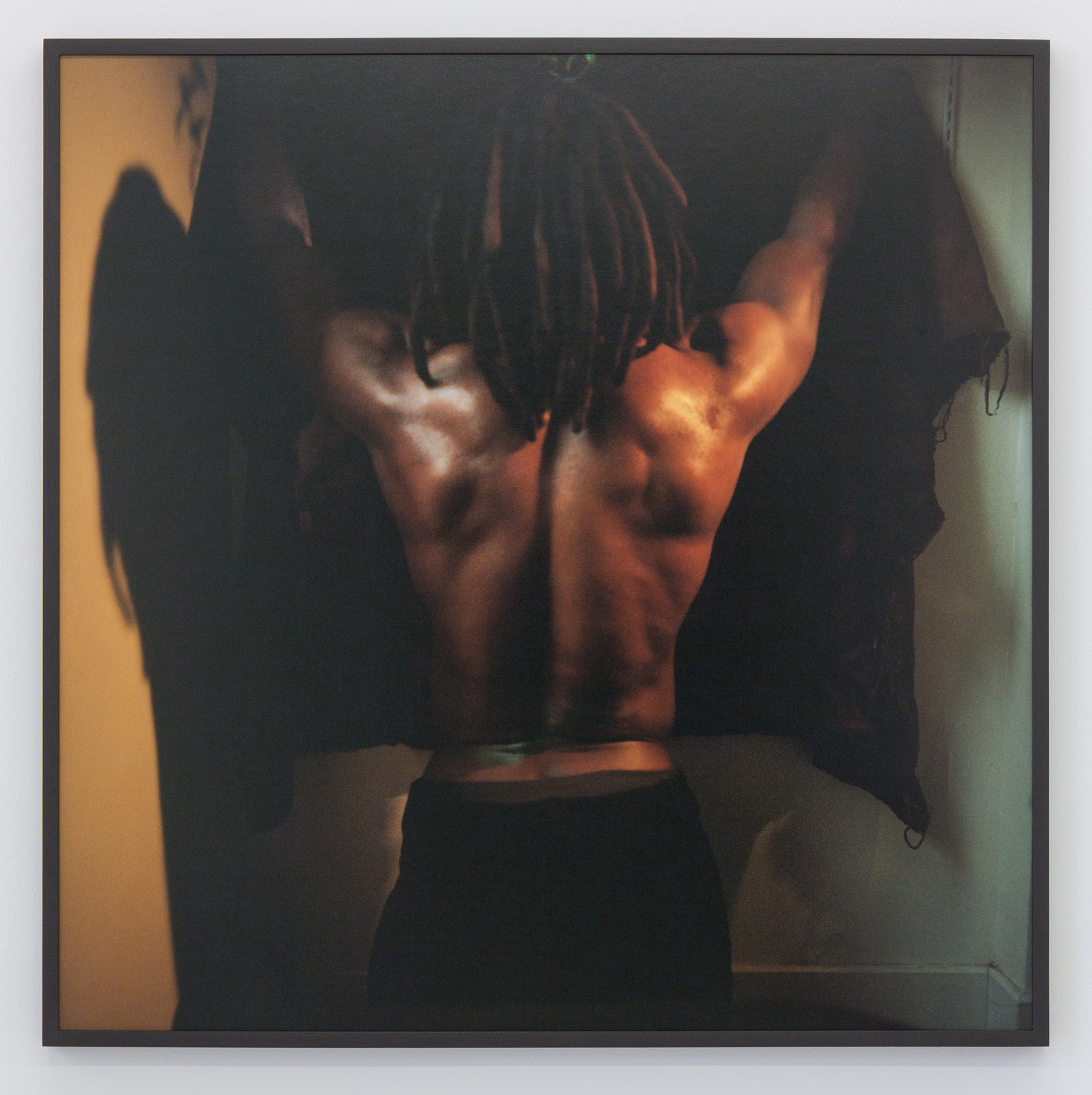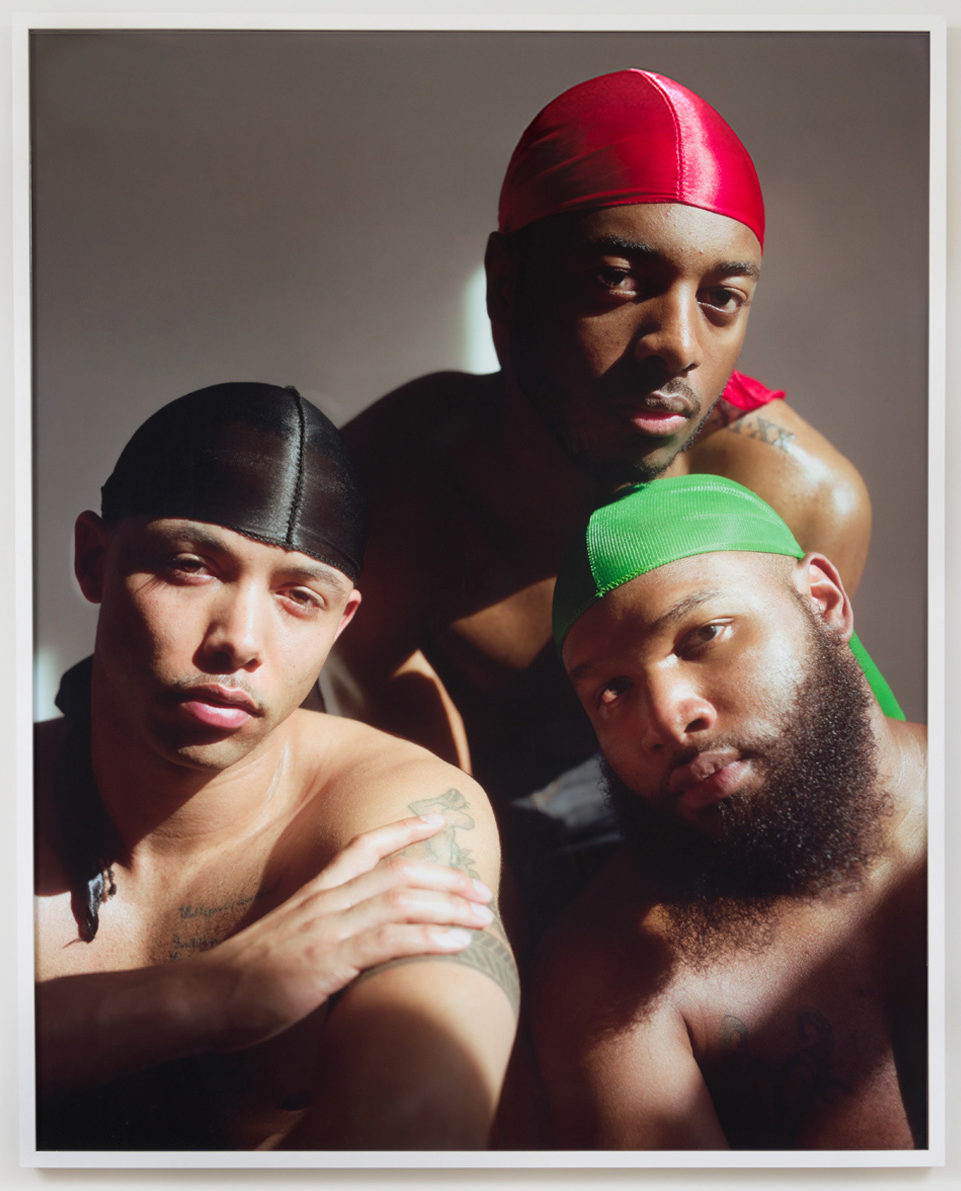John Edmonds’s Two Spirits (2019) both haunts and seduces. In the photograph, a bare-chested man wears a Baga bird mask from Guinea. Behind him hangs an African kuba cloth. In this ghostly work shot using multiple exposures, the masked head, in motion, appears doubled, while the sculpted chest of the subject is relaxed and steady. The title, which invokes the Baga people’s spiritual and ritualistic uses of masking, might refer to a concept among North American indigenous communities to describe nonbinary gender identities. “There is a difference between history and art history,” Edmonds said of the work in Interview. “Many masks and objects have been taken out of their original context and history, and as an African American, I’m interested in handling that.” Two Spirits also reflects the oscillation between masking and unclothing that more generally undergirds Edmonds’s exploration of race, history, sexuality, and class.
Wearing a mask, of course, can allude to W.E.B. Du Bois’s famous quote about double consciousness, but in Edmonds’s work it also references the nuanced and often quiet relationships between queer black men. The critic and curator Hilton Als has described how affecting he finds Edmonds’s work; responding to Edmonds’s 2014 video Shotgun, Als wrote in The New Yorker, “In it, two black men took turns blowing weed smoke into each other’s mouths. I was startled and moved by the intimacy of the piece, and, while watching it, I was saddened by the fact that the movie John had made was unusual, in part, because it showed two black men being loving, close, and how unusual was that?”
This was a big summer for Edmonds, who earned an MFA at Yale in 2016, and whose well-received series of portraits featuring young black men, many in du-rags and hoodies with their backs to the camera, was collected last year in his first book, Higher. Some photographs from this series, along with newer works, are featured in this year’s Whitney Biennial. Running concurrently with the Biennial, a solo exhibition, “Between Pathos and Seduction,” was on view at the Company Gallery in New York from June 6 through July 27. And in early July, Edmonds was awarded the Brooklyn Museum’s inaugural UOVO Prize for emerging Brooklyn-based artists, which includes a cash prize, a public installation, and a solo exhibition at the museum in 2020.
Amid all this recent recognition, Edmonds’s work has also been used to literally illustrate recent debates about black art, institutional inclusion, and art criticism. Paired with essays sparked by the Biennial, Edmonds’s photographs have served as a visual shorthand for the latest perennial debates about exclusivity in the art world. His images are evocative for their art-historical references, nods to canonical photographers, and utterly contemporary representations of black subjectivity, sexuality, and desire. Because his photographs are at once so accessible and historically layered, some critics and editorial teams reproduce his art seemingly as a stand-in for contemporary black art generally, as well as for black artists’ centuries-long struggle to be included in publications, museums, and other institutions.
Since its inception in 1973, the Whitney Biennial has been the subject of protests for its exclusion of artists of color and women of all races, as well as controversial representations of nonwhite subjects in the works of white artists. Most recently, when Dana Schutz’s Open Casket (2016)—a painting by a white female artist based on a photograph of Emmett Till’s body in his casket—was included in the 2017 Biennial, it prompted an open letter signed by a number of artists asking that the painting be removed and destroyed, followed by much public discussion and debate. (For more on this and the Whitney’s history of racial exclusion and racially insensitive exhibits, see Aruna D’Souza’s trenchant Whitewalling: Art, Race & Protest in 3 Acts.) It seems likely that the museum had this controversy in mind when it selected staff curators Rujeko Hockley, a black woman, and Jane Panetta, a white woman, to curate this year’s Biennial.
The show is deliberately more diverse in ways that exceed simple binaries of race and gender, with artists from a range of disciplines, regions, and a sizable number under the age of forty. At the same time, the show has been criticized for other forms of exclusion: that it features a preponderance of New York-based artists and Yale MFA alums. Critic and curator Danielle Jackson noted in Artnet that most emerging artists of color have little or no access to these elite institutions and networks. The show led Jackson to reflect on what happens when historically marginalized groups are absorbed by institutions that have historically excluded them: “Does inclusion of the formerly critical inherently serve to neutralize criticism?”
Advertisement
The black art critic Antwaun Sargent raised another issue, in response to coverage of the show. In a tweet that went viral in May and provoked its own cascade of responses, Sargent wrote, “It’s 2019 and we are in the middle of a Renaissance in black artistic production. And you are telling me the best people to evaluate that are the same ones who basically ignored black artists for decades?” While black artists and other artists of color have had more representation in international biennials and museum shows in recent years, the reception of their art is still often framed by a narrow and rarified cultural perspective. White male critics have had and continue to have the biggest platforms for interpreting art and culture. Sargent’s tweet elicited a number of responses on social media and in the world of art coverage.
What I find curious is how Edmonds’s images have circulated as part of this discussion, in support of various sides of the debate. That his photographs have repeatedly illustrated articles in recent debates suggests that, for critics and institutions, Edmonds’s art symbolizes the visibility of contemporary black arts—what Sargent calls a contemporary renaissance—and the history of institutional exclusion of black artists.
His photographs have accompanied reviews by older white male critics in legacy publications, as well as articles by writers arguing for a shakeup of the old white boys’ club of criticism. Illustrating Peter Schjeldahl’s largely negative review of the Biennial is Edmonds’s black-and-white photograph Young Man Wearing a Maternity Bust (from the Makonde) (2019). Schjeldahl, a white critic writing for The New Yorker, dismisses many of the works in this year’s Biennial as derivative and accuses co-curator Hockley of stirring “global paranoia.” He quotes her catalog essay—“There is nothing accidental about our heightened states of fear, mistrust, and anxiety. Unease is what we are meant to feel, what the stimuli we receive from our president, our media outlets, our twenty-first-century world are meant to engender”—and concludes: “Nobody here but us victims.”
Though Edmonds’s photograph was prominently displayed in the review, Schjeldahl never addresses the specific work. He characterizes Edmonds’s art in general as “Robert Mapplethorpe’s tony classicism translated into slang.” Though editors, not reviewers, typically choose the images that illustrate a writer’s work, it’s also true that most editorial offices of the major publications defining the coverage of the Biennial are conspicuously white. In any case, Edmonds’s images were clearly in the minds of editors and critics alike in the wake of this year’s Biennial and the debates that followed.
Edmonds’s photographs also illustrated rebuttals of reviews like Schjeldahl’s. Building on Sargent’s tweet, Elizabeth Méndez Berry and Chi-hui Yang cowrote an Op-Ed in The New York Times called “The Dominance of the White Male Critic.” Berry and Yang, who have created Critical Minded, an initiative to support and elevate critics of color, wrote:
At a time when inequality and white supremacy are soaring, collective opinion is born at monuments, museums, screens and stages—well before it’s confirmed at the ballot box… the spaces in media where national mythologies are articulated, debated and affirmed are still largely segregated. The conversation about our collective imagination has the same blind spots as our political discourse.
Edmonds’s Tête de Femme (2018) illustrated Berry and Yang’s article, though again his art is not discussed in their piece. Tête de Femme is a colorful reimagining of the white Modernist photographer Man Ray’s Kiki with African Mask (1926). In Ray’s iconic black-and-white photograph, a white woman’s head, eyes shut, rests on a surface next to an African mask. Edmonds’s photo shows a black woman’s face, eyes wide open and looking straight into the camera, beside a black and red patterned African mask—seemingly geared toward tourists with its medley of animal figures and its not-quite-wearable size, raising broader questions of origin and authenticity—which she holds up next to her head.
Among those who publicly disagreed with Berry and Yang was Kurt McVey, a white critic, whose inflammatory retort, titled “Kill Your Darlings: The End of the White Male Ally,” was published in White Hot Magazine. McVey took personal swipes at Sargent, accusing him of using Twitter for art criticism, as opposed to what McVey describes as carefully researched, in-depth writing. Unwittingly, McVey demonstrated the myopia and white male privilege that Sargent, Berry, and Yang critique when he argued that he has “pa[id] my dues and illustrate[d] my relevance through ongoing hard work, building a personal brand based on shared universal values… My audience is the human audience.” Here, the article curiously leads with Man Ray’s Kiki with African Mask (also known as Noire et Blanche) (1926), though McVey never addresses Ray’s art in his piece. But the presence of Ray’s well-known photograph can be read as a sleight of hand, invoking Edmonds’s Tête de Femme while implying that it is derivative of Ray, thus visually diminishing Edmonds’s work.
Advertisement
In one rare case, in which a writer directly engages with his work, Danielle Jackson writes that, upon first seeing it, she feared Edmonds’s would be the type of photography installation “that claims to center black people while secretly centering white audiences and their presumed prejudices.” The Villain (2018), which illustrates Jackson’s review, like many of Edmonds’s images, flips the idea of the villain, or black criminality, on its head: a black man looks out from behind a red bandanna that covers the lower half of his face. His hair is twisted in bantu knots and his eye brows are arched. The bandana and title play on familiar stereotypes of the black thug, but the subject’s seductive eyes, shirtless body, and supple shoulders suggest something else entirely. It evokes a stylized desire that is specific to black masculinity and queerness, but also to a working-class, street vernacular, an everydayness, that is more often objectified by museums and dominant culture rather than studied with the integrity that Edmonds brings to his work.
Instead of privileging white audiences, Edmonds’s photographs focus on quiet exchanges and expressions of longing among black subjects. What makes his work so accessible—and therefore, I believe, reproducible, but rarely critically engaged in the recent Biennial debates—is his complex use of racially coded objects: du-rags, incense, hoodies, bandannas, oversize T-shirts, hand signals, tattoos, and other visual markers. His striking images have, in recent debates, been more illustrative than interpreted partly because of their symbolic power. Edmonds’s work speaks directly to and about black subjects who have rarely crossed institutional thresholds of museums that have historically excluded representations of everyday black life—and is in conversation with that of other contemporary black photographers like Deanna Lawson and Zora Murff.
Edmonds clothes his portraits in familiar symbols of black masculinity, but the interactions between his subjects are premised on a largely unseen tenderness, vulnerability, and risk. The title of this summer’s solo exhibition, “Between Pathos and Seduction,” comes from a poem by the late poet Essex Hemphill, and the curatorial statement includes a passage from it: “New language beckons us. / Its dialect present. / Intimate. / Through my eyes / focused as pure, naked light, / fixed on you like magic, / clarity. I see risks…” Edmonds’s aesthetic vocabulary is the intimate risk-taking of a black queer bohemia, like his community in Brooklyn, recalling not only Hemphill but other black queer artists and writers of the 1980s and 1990s who were responding to the AIDS crisis—such as Rotime Fani-Kayode, the late Nigerian photographer, also a victim of AIDS, whose portraits focus on black queer sexuality, intimacy, and identity, and also included African masks and artifacts. Edmonds’s aesthetic vision of black queer sociality also gestures to black queer artists of the Harlem Renaissance who existed in quiet tension with The Talented Tenth and the New Negro movements.
In an interview with Garage, Edmonds said that his work is not only, or not explicitly, about the erotic. He collaborates with his subjects—strangers as well as people he knows—to explore a space for “cultivating an energy within a picture that feels shared… that feels like it’s part of a circuit of possibilities.” In a two-channel video included in his solo show, Edmonds depicts two black men, each in a separate channel, whom Edmonds has asked to hold up an African kuba cloth on a wall in his kitchen, a seemingly easy task. But the video, which focuses on their backs and arms stretched against the cloth and wall, shows each struggling. Their muscles flexing in exertion as they struggle to hold the tapestry in place and smoke wafting across each channel are the only movement.
Edmonds and his subjects are involved in what critical theorist Saidiya Hartman calls “beautiful experiments” as they play with conventions to cultivate new possibilities of black queer intimacy. Risks are taken—Edmonds’s request of a sitter, a blow of smoke between two men—to forge a connection, a freedom found within the forms of art historical tropes, turned on their heads. Edmonds’s risk-taking has received critical praise and enviable recognition in some of the most prestigious art institutions. But while recent debates around the Biennial have been fast-paced and loud, Edmonds’s work is a quiet seduction that unfolds over time. In one photograph, three seated shirtless men in du-rags—one red, one green, one black—are posed with light streaming down on them, casting shadows. They look directly into the camera, their expressions calm—wise, perhaps beatific, maybe seductive. The photograph, titled American Gods (2017), seems to ask: What do we see when we look?
“Between Pathos & Seduction” was at the Company Gallery from June 6 to July 27. The Whitney Biennial, which features work by John Edmonds, is at the Whitney Museum through September 22.


